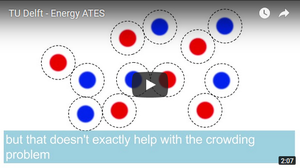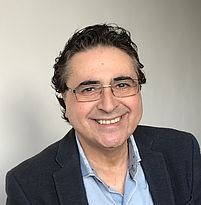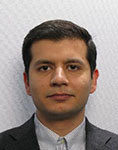Storage
-
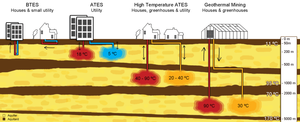
The subsurface provides large space to store heat at various scales in terms of volume and time. In areas with suitable layers, heat storage in the subsurface is one of the most cheapest and suitable technology.
Borehole thermal energy storage systems (BTES) in near surface and shallow layers (10s to 100s of meters) allow for seasonal storage of heat, essentially using the Earth as a thermal battery. BTES are applied for small and/or single buildings. Aquifer thermal energy storage systems (ATES) in the shallow subsurface (100s of meters) provide large-scale storage capacity and can be applied for large buildings as well as at for a combination of buildings/houses. Water of different temperatures can be stored in such systems.BTES and ATES up to 20°C require very well insulated buildings. Therefore, this technologies is only applied in new buildings or deep retrofitted older building. For high-temperature ATES, the preferred storage temperature for the existing building stock, the legislation is still very cautious due to insufficiently known effects on the ground water quality.
The storage capacity of the subsurface can only be fully exploited, if the overall installation of storage systems in the subsurface space is well designed. This includes spatial planning of ATES wells and control of subsurface space use in smart grids, rather than optimizing individuals wells.
As decarbonising the existing building stock is a key challenge in the energy transition, we focus our research on heat storage for existing buildings in high-temperature ATES. Main topics of interest are related to the effects of the temperature difference between injected return water and the subsurface, e.g. buoyancy that affects the recovery efficiency, shifts in chemical equilibriums that may result in clogging, and effects on the ground water quality.
In addition, we study the governance of the local subsurface with ATES smart grids. These projects are in cooperation with the <link powerweb research-projects urses-projects aquifer-thermal-energy-storage-smart-grids-ates-sg-urses>PowerWeb Platform.
The dynamics of storage and recovery cycles result in the repetitive heating and cooling down of the specific target layer and its covering layers. In urban areas, where ATES systems may be very close to each other, hydrological and thermal interference has to be prevent. Recent research has shown that ATES systems could often be placed much closer to each other in order to optimize the exploitation of the ground energy. Developing operational frameworks for the optimization is one of the biggest challenges for ATES research. Temperatures, volume and frequency of the cycles vary between application areas. In the built environment, seasonal storage of low temperature heat is most relevant, capturing the summer heat for use in winter (often in combination with a heat pump), and using the cold groundwater to provide cooling during summer. When district heating is used (currently at high temperatures), the heat storage requires higher temperatures than regular ATES; which is currently only allowed in pilot studies. For industry applications, shorter cycles with higher temperature are needed; when ATES systems are used, the use of heat pumps can be reduced and/or made more efficient by working on higher temperatures.
-
In the future, surplus electricity from renewable energy sources will be used electrochemical conversion of into solar fuels (poxer to X, see eRefinary. Subsurface storage is the most promising way for large-scale, long-term storage of these solar fuels, that can later on be used for (electricity and) heating purposes.
Fundamental knowledge on the cyclic geomechanical response of the subsurface to the imposed dynamic cycles of in- and output is still lacking and potential risks of subsidence and leakages need to be explored.
-
Heat batteries will increasingly complement electric batteries in a built environment (and possibly the mobile sector). They are based on phase change materials (PCMs), thermo-chemical materials (TCMs), and phase change slurries (PCS).
New advanced materials need to be developed and the processes brought to a high efficiency-level.

Martin Bloemendal
long-term, centralized subsurface heat storage (ATES/HTO)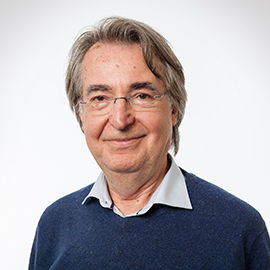
Carlos Infante Ferreira
Heat pumps, solar driven applicationsAquifer Thermal Energy Storage Smart Grids (ATES-SG)
ATES-SG+
